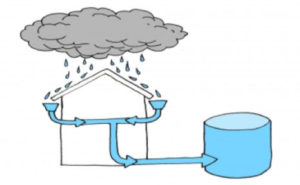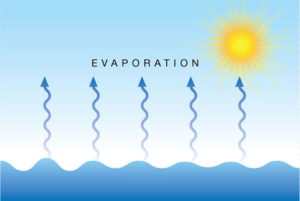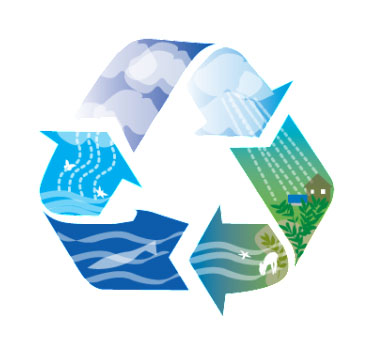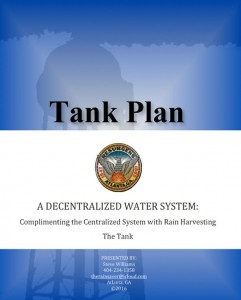
This proposal will explain how using rainwater harvesting as a Best Management Practice (BMP) to reduce flows during rain events and use the water for non-potable needs. Water captured from storm events can be sold to customers needing non-potable water through the leasing of tanks and access to water from larger tanks.
The idea of a decentralized system came to me in stages after I realized the potential that rainwater harvesting could bring to our area. I witnessed landscaping trucks watering plants, people washing sidewalks and urban gardens trying to supplement irrigation with rain barrels. All were using potable water. If rainwater harvesting systems (RHS) were placed through out a city to supply clean non-potable water, much of our water could be supplied directly from the rain. The problem of implementing RHS on a large scale in the private sector is a large upfront cost and lack of short-term payback on the investment. Many irrigation RHS will take will have a payback of 10 years or more due to seasonal use and the erratic climate patterns; however, once installed, cost and maintenance are minimal. A RHS should have a life cycle of 20-30 years or more giving a positive return on 10 years or more to payback, because they have seasonal use and the erratic climate patterns we investment. If the utilities had a revenue source from rain harvesting they would embrace the practice. Through my investigation in this project, the lower energy requirements discovered and stormwater management benefits in RHS are the key to making them economical. This led me to realize that this concept could be used as a self funded stormwater utility that provides a product (water) for a fee to pay for the utility cost.
 RHS offer an efficient way to collect and store water when compared to reservoirs. Evaporation from Lake Lanier for example is about 40 inches per year with an annual average precipitation of 54.8 inches, which calculates to a 73% loss of water according to a US Department of Commerce Technical Paper.This plan will explain how the City of Atlanta’s Department of Watershed Management (DWM) and other utilities in moderate to wet climates can use rainwater to supply their non-potable water needs and keep more of the revenues generated from the sale of this water.
RHS offer an efficient way to collect and store water when compared to reservoirs. Evaporation from Lake Lanier for example is about 40 inches per year with an annual average precipitation of 54.8 inches, which calculates to a 73% loss of water according to a US Department of Commerce Technical Paper.This plan will explain how the City of Atlanta’s Department of Watershed Management (DWM) and other utilities in moderate to wet climates can use rainwater to supply their non-potable water needs and keep more of the revenues generated from the sale of this water.
Satisfying the Nation’s water needs requires energy for supply, purification, distribution, and treatment of water and wastewater. Electricity costs represents approximately 75 percent of the cost of municipal water processing and distribution (Powicki, 2002) according to the ENERGY DEMANDS ON WATER RESOURCES by the US Department of Energy. The cost of treatment for RHS will only include maintenance of the filters, maintenance of the tanks and the cost of electricity.
- Tanks can be set up at parks, urban farms and urban gardens for irrigation.
- Tanks can be set up for businesses to supply non-potable water.
- Leased tanks are charged as a flat fee based on cost of the system.
- The utilities sets up rain tanks they own throughout the city, maintain and sell water to businesses though blue fire hydrants.
- Selling rainwater will generate more revenue then domestic water.
- Stormwater management reducing flooding and stream pollution.
- Training and testing facility for city inspectors, designers and contractors.
- New source of revenue for utilities.
- Public Private Partnerships
- A revenue source for stormwater practices.
By managing rainwater and stormwater efficiently would insure plenty of water for generations. Expanding the reservoir system with the cost of land, new infrastructure, energy use, environmental issues and the loss due to evaporation seems futile. A decentralized system can be implemented within several years instead of the decades it takes to complete a reservoir. With drought conditions forecast for Georgia in the near future, now is the time to consider implementing this plan.
For more information on the benefits of rainwater harvesting read the 2 papers (click on Image) that support rainwater harvesting as an alternative to domestic water supplies lead by Santosh R. Ghimire, Ph.D. M. ASCE, M. AAAS Global Sustainability and Life Cycle Consultant LLC www.gslcconsultant.com
To learn more about the project click on the Rainwater Harvesting Utility Summary on the left or the Tank Proposal on the right.





